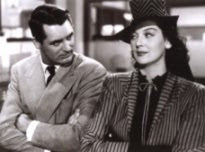Some good news this week.
A lost Jack Lemmon film has been rescued from oblivion, dusted off and made available on DVD, letterboxed, by Paramount/CBS.
Stuart Rosenberg's "The April Fools" is an irresistible confection from 1969 that offers Lemmon in one of his last great comedic screen performances and, as a bonus, casts him opposite no less than Catherine Deneuve.
Deneuve made a rather interesting, surprising partner for Lemmon, given that she was the international "It" girl of the moment. Maybe not too much of a surprise: After all, five years earlier, Lemmon had played opposite another European dish, Romy Schneider, in "Good Neighbor Sam."
That said, "The April Fools" is a blissfully blatant male fantasy in which the star plays his quintessential Lemmon character, in this case an Everyman who falls in love with Catherine Deneuve - and, improbably, she returns the affection. Unlikely? The film is also blissfully oblivious.
The two meet at a party hosted by Deneuve's husband (Peter Lawford who, by the way, appeared with Jack in Lemmon's debut film, 1954's "It Should Happen to You"), spend the night clubbing (in the company of eccentric night couple Myrna Loy and Charles Boyer) and then fly off to Paris together the next morning, with Lemmon leaving behind his wildly acquisitive wife, Sally Kellerman (who is nothing less than outstanding here as a vain, selfish woman who talks exclusively in psychobabble).
It's a soufflé, nothing more, and adding to the mix are the invaluable Jack Weston and Harvey Korman as Lemmon's attorney and a sex-addicted businessman, respectively - two buttoned-down, acoholic Mad Men - and Melinda Dillon and Kenneth Mars as a (then) New Age couple. ("Fools" was also the first film scored completely by Marvin Hamlisch, although precious little of his excellent mood music ended up on the movie's soundtrack album, which opted to showcase the songs utilized in the film instead.)
A bit of trivia: "The April Fools" was produced by the CBS subsidiary, Cinema Center Films, an early boutique lable that functioned between 1968 and 1972, producing some 40 titles, all distributed by National General Pictures. In tandem, Cinema Center and National General collaborated on some mighty fine films but both companies, way too good to be true, ultimately went under sometime in the mid-'70s.
Ten of their titles - "Little Big Man," "The Reivers," "The Boys in the Band," "Monte Walsh," "Big Jake," "Scrooge," "Le Mans," "Rio Lobo," "A Man Called Horse" and "With Six, You Get Eggroll," the first Cinema Center release as well as Doris Day's final theatrical film - show up on Turner Classic Movies with some regularity. "The April Fools," despite that ace cast, has evaded its schedule, along with a few others - such as the Angela Lansbury-Michael York cult film, "Something for Everyone," Patty Duke's very fine "Me Natalie," Dustin Hoffman's "Who Is Harry Kellerman and Why Is He Saying Those Terrible Things About Me?" and another Lemmon title, "The War Between Men and Women," also new to DVD.
Hint to TCM.

It's interesting to note that both Lemmon's "The April Fools" and Doris Day's "With Six, You Get Eggrolls" were their stars' respective attempts to move, however cautiously, into the New Wave of filmmaking that cropped up in the late 1960s and early '70s. But, frankly, neither one seemed terribly comfortable with the obligatory go-go sequences and other youth-oriented references that were shoehorned into their films. They didn't need this, and in the case of Day, she looked a tad embarrassed.
As for Stuart Rosenberg (1927-2007), he came to movies from TV. Not a good thing from the viewpoint of your standard cinéphile.
I, of course, disagree.
Rosenberg began his film work belatedly in 1967, making an auspicious debut with Paul Newman's "Cool Hand Luke," the inaugural production of Lemmon's Jalem Productions ("The April Fools" was the second Jalem film) and would direct only a handful of theatrical films - fourteen in all, including one using the familiar psuedonym, Alan Smithee.
He would make three more films with Newman, all estimable - "WUSA" (1970), "Pocket Money" (1972) and the Lew Harper flick, "The Drowning Pool" (1975) - and also work with Redford on "Brubaker" (1980). But Rosenberg's most impressive work was with Walter Matthau on the edgy "The Laughing Policeman" (1973) and with soulmates Eric Roberts and Mickey Rourke on the iconic "The Pope of Greenwich Village" (1984).
As for my favorite Rosenberg titles, they would be two back-to-back items that tend to come in under the radar - again, "The April Fools," and "Move," one of four titles that Elliott Gould made in 1970, a hip take on the era's trendy Euro filmmaking. But more about that film later.




























